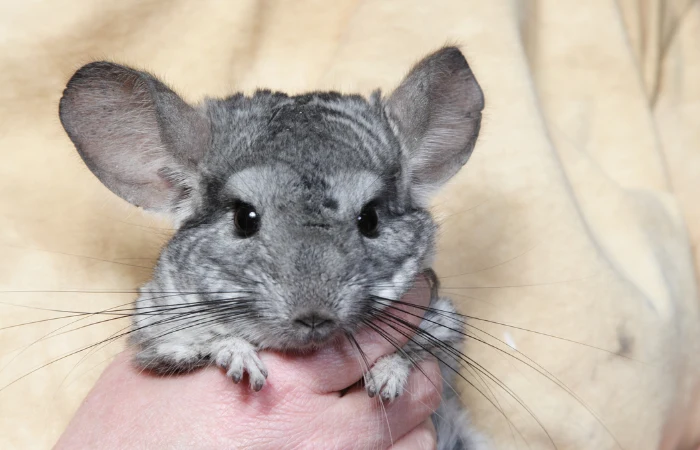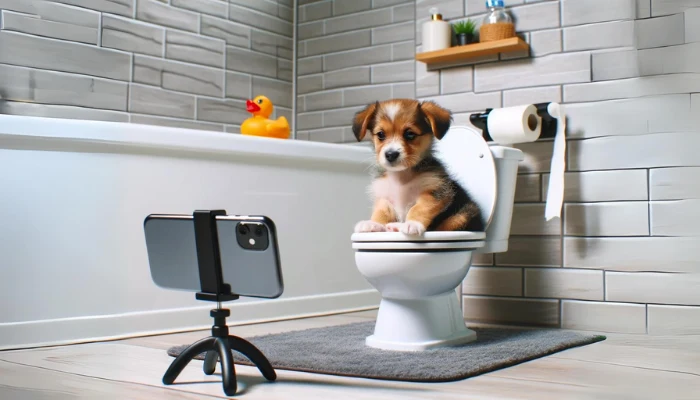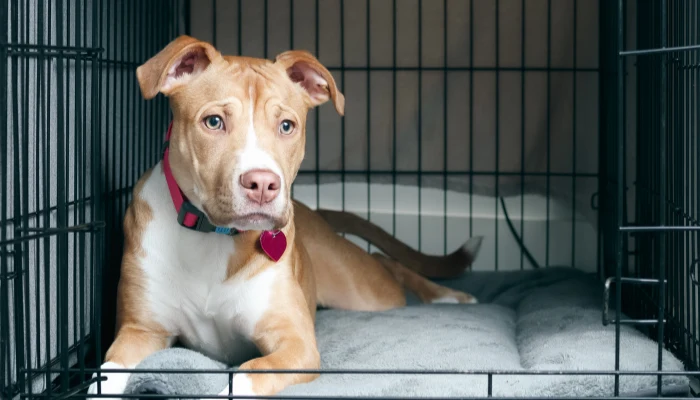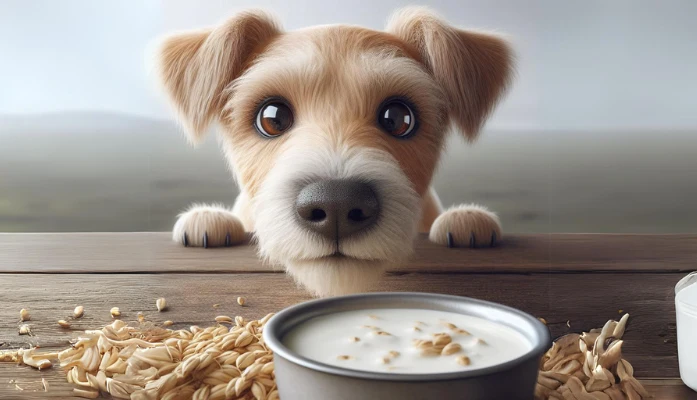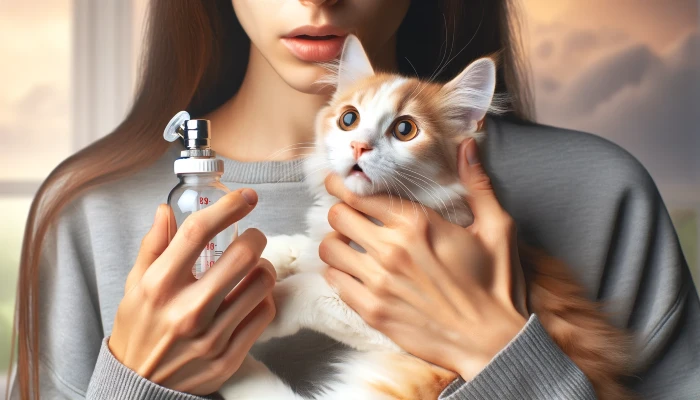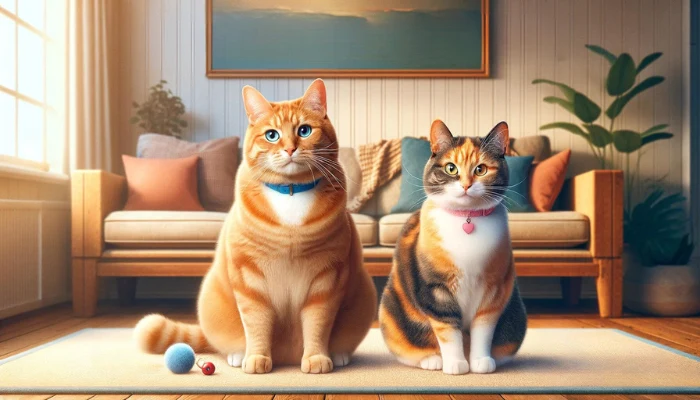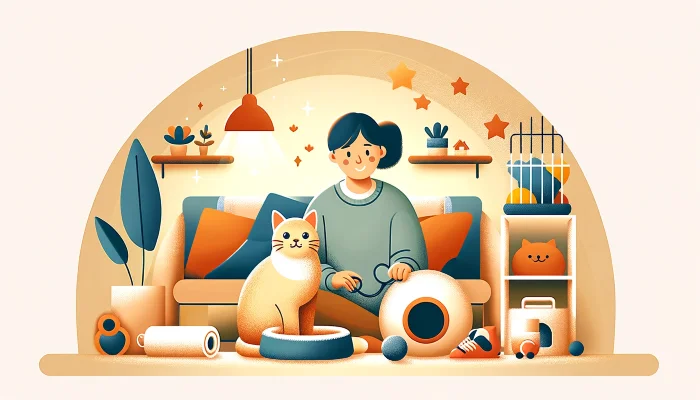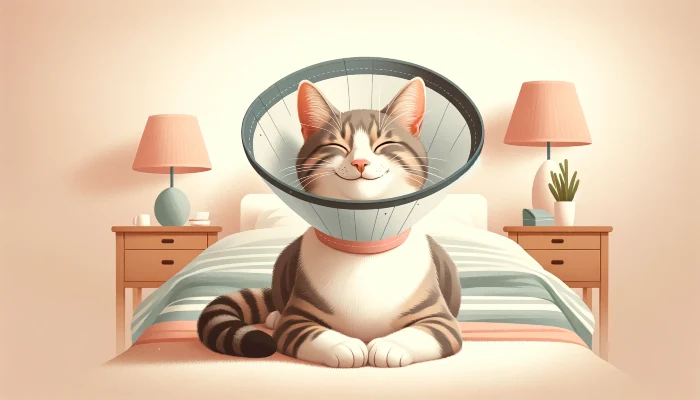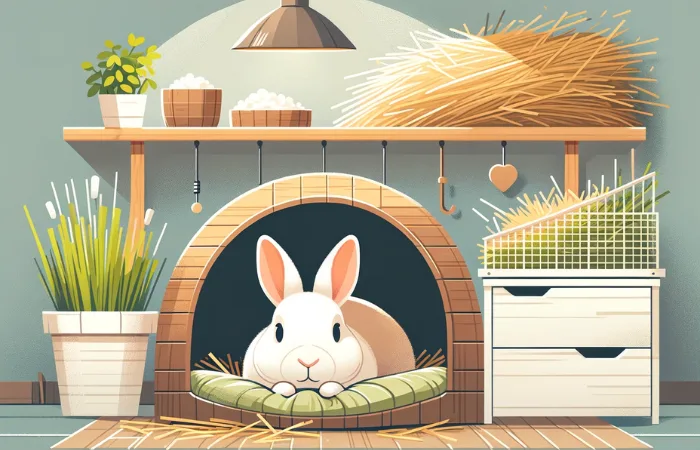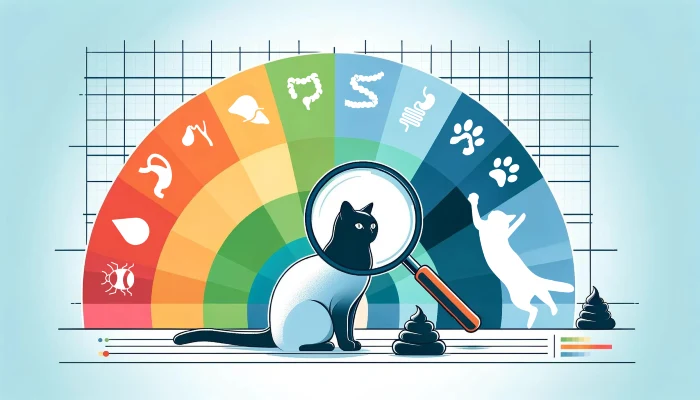Welcome to the delightful world of chinchilla care! These endearing little fluffballs are more than just cute faces; they’re complex creatures with specific needs. Whether you’re already a proud chinchilla parent or contemplating bringing one of these furry bundles of joy into your life, this guide is here to illuminate the path to successful chinchilla ownership.
In this article, you will learn:
- Essential considerations for choosing the ideal cage, ensuring your chinchilla’s home is a haven.
- Nutritional guidelines and healthcare tips to keep your chinchilla thriving.
- Strategies for forging a deep, meaningful bond with your chinchilla, enhancing both your lives.
Embark on this journey to become the best chinchilla caretaker you can be, armed with the knowledge and tips shared here.
Choosing the Right Cage
Selecting the perfect cage for your chinchilla isn’t just about aesthetics; it’s a crucial decision impacting their quality of life. These active and acrobatic animals need ample space to jump, play, and explore, making the size and design of the cage paramount.
Spaciousness Is Key: Chinchillas thrive in an environment that allows them to move freely. A multi-level wire cage, preferably at least 24 inches long by 24 inches wide and 36 inches tall in order to allow a few different levels, so it provides the necessary space for exercise and exploration. Be sure to double the minimum size if you are getting two chinchillas. Always provide the largest cage possible for your furry friend.
Safety and Comfort: The materials of the cage matter. Choose a cage with solid flooring, as wire floors can hurt their delicate feet, and no one wants that! Ensure there’s adequate ventilation to keep your furry friend comfortable and healthy. Also, never buy or use galvanized wire for your chinchilla’s cage as it contains zinc, which is toxic when it’s ingested.
Location, Location, Location: Place the cage in a quiet, temperature-controlled area of your home. Chinchillas are sensitive to heat and humidity, so a cool (they prefer temps between 60 and 75 degrees F), dry environment away from direct sunlight is ideal.
Personal Touch: Customize the cage with safe toys, hiding spots, and chewable items to stimulate their curious minds. Remember, a happy chinchilla is an active and engaged one.
In the next section, we’ll explore bedding options, a crucial aspect of your chinchilla’s habitat for their comfort and health.
Bedding Options: Carefresh vs. Hemp
Creating a comfortable and safe environment in your chinchilla’s cage is vital, and bedding plays a significant role in this. Two popular bedding options are Carefresh and hemp bedding, each with its unique benefits.
Carefresh Bedding: Known for its softness, Carefresh is made from recycled paper, making it an eco-friendly choice. It’s highly absorbent, controlling odors effectively, and is dust-free, which is essential for the sensitive respiratory systems of chinchillas. However, it’s important to change it regularly to maintain hygiene.
Hemp Bedding: Hemp bedding is gaining popularity due to its sustainability and durability. It’s highly absorbent, biodegradable, and has natural odor control properties. Hemp is also less likely to cling to your chinchilla’s fur, which can be a plus for grooming. One consideration is its availability and cost, which can vary depending on your location.
Making the Choice: The choice between Carefresh and hemp bedding depends on your preferences and your chinchilla’s needs. Some owners find a combination of both works best, providing the comfort of Carefresh with the sustainability and durability of hemp. Both Carefresh and Hemp bedding can be added to your compost bins after cage cleaning, so not only do they keep your chinchilla clean, but they also help keep the environment clean.
In the following section, we’ll delve into the fascinating world of chinchilla dust baths, an essential aspect of their care routine.
Understanding Chinchilla Dust Baths
Chinchilla dust baths aren’t just adorable; they’re a critical aspect of chinchilla care. In their native Andean habitat, chinchillas roll in volcanic ash to clean their dense fur. This instinctual behavior is vital for their health and well-being, and… it’s adorable to watch.
The Necessity of Dust Baths: Chinchillas have incredibly dense fur, with about 60 hairs growing from a single follicle. Water bathing can cause their fur to clump and lead to skin issues. Dust baths help absorb oils and dirt, keeping their coat clean and fluffy.
Choosing the Right Dust: Not all dust is created equal for chinchilla baths. Ensure you use a fine, dust-free bathing powder specifically designed for chinchillas. This type of dust mimics the natural volcanic ash of their native environment.
Bath Time Routine: Offer your chinchilla a dust bath 2–3 times a week for about 10–15 minutes each time. Be sure to not leave the dust bath in your chins cage for long periods of time because over-bathing can dry out their skin, so it’s important to find a balance.
Bath House Setup: Use a container large enough for your chinchilla to roll around in comfortably. You can purchase dust bath houses online or in the pet store, or you can use any plastic, glass or ceramic container that provides an enclosed space for the chinchilla to roll around in but won’t let the dusting powder be spread all over. Place it in their cage, and watch them enjoy their spa time! Remember to clean the bath house and replace the dust regularly to maintain hygiene.
Next, we’ll look into the temperament of chinchillas and what you can expect in terms of your relationship with these fascinating creatures.
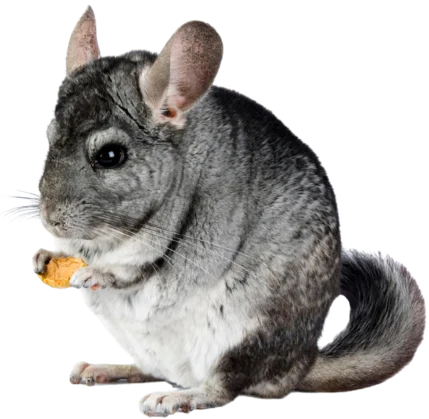
If a chinchilla sees another chinchilla being fed before them, they can have stress convulsions.
A Chinchilla’s Temperament and How To Build A Relationship With Your Chinchilla
Understanding a chinchilla’s temperament is key to forming a strong and rewarding bond. Known for their playful and inquisitive nature, chinchillas can make delightful companions, but they also have unique behavioral traits.
The Playful Explorer: Chinchillas are naturally curious and active, especially during the evening and night. They love to explore and play, so providing a stimulating environment with toys and space to move is essential for their happiness.
Building Trust: Initially, chinchillas may be shy or reserved. Building trust takes time and patience. Start by spending time near their cage, talking softly, and offering treats from your hand. Consistent, gentle interactions can help them grow comfortable with your presence.
Handling with Care: When your chinchilla is ready for handling, always be gentle. Support their bottom and hold them close to your body to make them feel secure. Abrupt movements or loud noises can startle them, so it’s important to create a calm environment. Never pick your chinchilla up by the tail as this can cause injury.
Understanding Their Needs: Chinchillas express themselves through sounds and body language. A happy chinchilla might chirp or jump (known as “popcorning”), while a raised tail or teeth chattering can indicate discomfort or fear. Learning to interpret these signs will enhance your communication and bond.
Next up, you’re going to learn the best ways to handle and engage with your new chinchilla to help form that ever-lasting bond!
Handling and Training Your Chinchilla
Proper handling and training are important for building a trusting relationship with your chinchilla. These gentle creatures respond best to patience and positive reinforcement.
Training Basics:
- Start with Trust: Training begins with trust. Spend time with your chinchilla daily, allowing them to get comfortable with your presence.
- Simple Commands: You can teach simple commands like coming when called by using treats as rewards. Consistency is key.
- Litter Training: Chinchillas can be litter trained with patience. Place a litter box filled with their bedding in a corner of their cage where they use the bathroom the most, and encourage its use by placing some of their soiled bedding in the box. Be sure to never use cat litter as it can be ingested, and the dust can cause respiratory issues.
Respect Their Boundaries: Remember, every chinchilla has its own personality and comfort level with handling and training. Respect their boundaries and never force interaction.
Creating a Bond: Through regular, gentle interaction, you can create a strong bond with your chinchilla, making handling and training a positive experience for both of you.
Healthcare and Common Health Issues in Chinchillas
Ensuring your chinchilla’s health starts with understanding their specific needs and common ailments. Regular check-ups and keen observation are key to keeping them in good health.
Routine Healthcare: Annual veterinary check-ups are recommended for chinchillas. These visits can help catch any health issues early. Ensure your vet is experienced with exotic pets like chinchillas.
Dental Health Essentials: Chinchillas have open-rooted teeth, which means their teeth continuously grow throughout their life. Overgrown teeth can lead to serious health issues. Offer plenty of chew toys and hay, which help naturally grind down their teeth. If you notice that your chinchillas teeth are getting too long or any other abnormalities, be sure to take your chin to the vet as soon as possible to avoid any health issues.
Digestive Health: A chinchilla’s digestive system is delicate. Sudden changes in diet or inappropriate foods can cause gastrointestinal issues. Stick to a high-fiber, low-fat diet, and introduce new foods gradually.
Respiratory Concerns: Chinchillas can be prone to respiratory infections, often indicated by symptoms like wheezing, coughing, or nasal discharge. Dust-free bedding and a clean living environment are crucial to prevent these issues.
Heatstroke Prevention: Chinchillas don’t tolerate heat well. Keep their environment cool (ideally below 75°F) and provide a dust bath to help them regulate their body temperature.
By being attentive and proactive, you can ensure your chinchilla stays healthy and happy.

In the wild, chinchillas are an endangered species due to poaching for their pelts and loss of habitat.
Nutrition for Your Chinchilla
A proper diet isn’t only essential for your chinchilla’s overall health, but also crucial for maintaining their dental health. Understanding the intricacies of their dietary needs and dental care is key to a healthy chinchilla.
The Ideal Diet: Chinchillas require a diet high in fiber and low in fat. High-quality chinchilla pellets should make up the bulk of their diet, supplemented with a good quality timothy hay. Hay not only aids in dental health but also in proper digestion.
Fresh Greens and Treats: While chinchillas enjoy fresh greens, these should be given sparingly to avoid digestive problems. Treats should be given in moderation; look for healthy options like dried kale or dandelion leaves. A list of some safe and unsafe foods is available below.
Water Intake: Always ensure your chinchilla has access to fresh, clean water. A water bottle with a metal spout is recommended to prevent chewing.
By prioritizing dental care and proper nutrition, you’re setting the foundation for a healthy and happy life for your chinchilla.
In the next section, we’re going to dig into the specific dietary needs of your chinchilla, including what foods to avoid.
Dietary Dos and Don’ts for Chinchillas
A well-balanced diet is essential for a chinchilla’s health. Understanding what foods are safe and beneficial, as well as those to avoid, can help you make the best dietary choices for your furry friend.
Safe and Nutritious Foods:
- Pellets: High-quality chinchilla pellets should form the basis of their diet.
- Hay: Timothy hay is the best choice for chinchillas and is excellent for digestion and dental health and should be always available.
- Fresh Greens: In moderation, fresh greens like kale and herbs can be offered occasionally. Introduce any new greens slowly to avoid digestive upset.
Foods to Avoid:
- Sugary Treats: Foods high in sugar, like fruits and some vegetables, should be avoided as they can lead to diabetes and other health issues.
- Nuts and Seeds: These can be high in fat and aren’t suitable for chinchillas.
- Processed Foods: Avoid any human food or processed treats not specifically formulated for chinchillas.
Water: Fresh, clean water must always be available. Use a water bottle with a metal spout to prevent chewing.
Moderation and Variety: While consistency is key in a chinchilla’s diet, occasional safe treats can add variety and enrichment. Remember, any dietary changes should be introduced gradually to avoid upsetting their sensitive digestive system.
Safe & Unsafe Foods
- Carrots
- Celery
- Dandelion greens (from untreated areas)
- Fresh herbs
- Kale
- Squash
- Sweet Potatoes
- Turnip, Mustard, Beet and Carrot greens
- Banana
- Cabbage
- Corn
- Spinach
- Broccoli
- Asparagus
- Avocados
- Rhubarb (stalks and leaves)
- Nuts & Seeds
Exercise Needs and Toy Ideas for Chinchillas
Chinchillas are energetic creatures that require regular exercise to maintain their physical and mental health. Providing the right toys and exercise opportunities is crucial for their well-being.
Exercise Essentials: Chinchillas need space to run, jump, and play. If possible, create a safe, chinchilla-proof (they will chew on everything, woodwork furniture and cords) area outside their cage where they can explore and exercise daily. Ensure this space is free of hazards and escape routes. Always be sure to supervise your chinchilla when he isn’t in the cage. Building a safe exercise pen is a great way to ensure your chinchillas’ safety as well as your homes.
The Right Toys: Toys aren’t just for fun; they’re essential for a chinchilla’s dental health and mental stimulation. Offer a variety of chew toys, such as wooden blocks or pumice stones, to help keep their teeth trimmed. Hanging toys, tunnels, and platforms in their cage encourage exploration and climbing.
Wheel Workouts: An exercise wheel can be a great addition to their cage, but it must be chinchilla-safe. Look for a solid, large wheel (at least 14 inches in diameter) with no spokes or gaps to prevent injuries.
Avoid Plastic: Chinchillas love to chew, so avoid plastic toys that could be ingested and cause health issues. Stick to natural materials like wood, hay, and pumice.
By incorporating these exercise and play elements into your chinchilla’s routine, you’ll help ensure they stay healthy, happy, and engaged.
Cleaning and Grooming Your Chinchilla
Proper cleaning and grooming are crucial for maintaining your chinchilla’s health and well-being. These tasks, while simple, require regular attention to ensure your pet stays comfortable and clean.
Cage Cleaning Routine: Regular cleaning of the chinchilla’s cage is essential to prevent the buildup of harmful bacteria and maintain a healthy environment. Weekly deep cleaning of the cage, along with daily spot checks, wiping down of all platforms and removal of soiled bedding, helps keep the habitat fresh. For the weekly deep cleaning, be sure to remove your chinchilla and keep him in a safe enclosed play area until the cage is dry.
Fur Care: Chinchillas have dense fur that needs regular dust baths to stay clean. As previously mentioned, providing a dust bath 2–3 times a week is sufficient. Avoid bathing them in water, as it can mat their fur and lead to skin problems.
Grooming Sessions: While chinchillas groom themselves naturally, occasional gentle brushing can help remove loose fur and prevent matting, especially in long-haired breeds. Use a soft brush designed for small animals.
Nail Trimming: Chinchilla nails can become overgrown in captivity and may need trimming, although filing the longer nails is often all you need to do. Providing a few wooden surfaces in the cage is typically enough to help your Chinchilla keep his or her nails naturally short.
By maintaining a clean living space and grooming your chinchilla regularly, you’re contributing significantly to their overall health and happiness.
Understanding Chinchilla Lifespan and Color Varieties
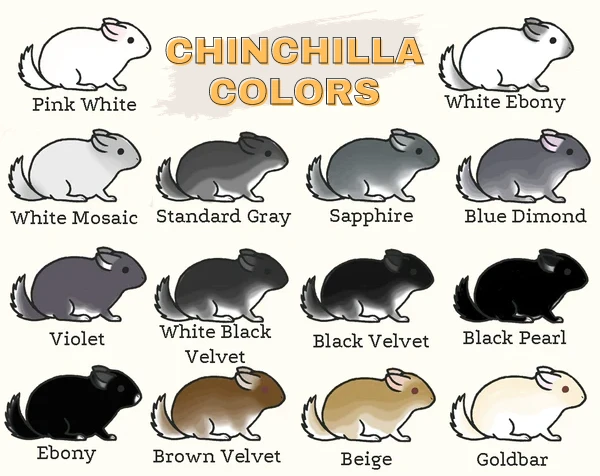
Chinchillas aren’t only diverse in personality but also in their lifespan and color varieties. Understanding these aspects can enhance your appreciation for these unique creatures.
Most people are surprised to learn that chinchillas have a remarkably long lifespan for small pets, often living 15 years or more with proper care. Some have been known to reach 20 years of age in captivity.
Meaning… adopting a chinchilla is a long-term commitment. Ensuring their health and happiness over the years requires dedication and understanding of their needs as they age.
Chinchillas come in a variety of colors. The standard natural color of a wild chinchilla is a mix of gray, black, and white. This coloration helps them blend into their natural environment. Of course, you could also opt for what are commonly known as bred colors.
Through selective breeding, chinchillas are now available in various colors, including white, beige, ebony, and even velvet. These color variations don’t affect their care requirements and have no barring at all on their personality traits.
And while the color variety you choose doesn’t dictate your new chinchilla’s character, some specific bred color varieties may be prone to specific health issues. This is no different from some breeds of dogs that have been genetically weakened over time in the pursuit of specific physical traits. Research and consult with breeders or veterinarians if you’re considering a specific color variety.
Understanding the lifespan and the range of beautiful color varieties of chinchillas allows you to fully appreciate these fascinating animals, whether you’re a seasoned owner or considering adopting one.
In conclusion, embarking on the journey of caring for your first chinchilla is a truly rewarding experience. These fluffy, adorable creatures can bring immense joy and companionship to your life, but they also require your commitment, patience, and love in return.
As you’ve learned throughout this article, providing your chinchilla with a safe, comfortable environment, a balanced diet, regular social interaction, and proper healthcare is essential for their well-being. It’s important to remember that chinchillas are unique, each with their own personality and needs. Taking the time to understand and connect with your furry friend will deepen the bond between you and ensure a happy, healthy life for your chinchilla.
So, whether you’re a new chinchilla owner or considering bringing one into your home, remember that the journey is just as rewarding as the destination. Cherish the moments you share with your chinchilla, learn from each other, and relish the joy that comes from caring for these charming little creatures. With the right knowledge and a lot of love, your chinchilla will become not just a pet but a cherished member of your family. Here’s to many years of happiness and adventure with your newfound friend!
Chinchilla FAQ
Should I get one or two chinchillas?
Chinchillas are social animals and would do best if kept in same sex pairs. It’s easier to get two from the same litter than trying to introduce a new one later down the road.
More To Discover
Do males or females make better pets?
There’s no difference in the temperaments of the males or females, both sexes are equally affectionate with their owners when properly handled. Females do tend to be a little more territorial than the males.
How high can chinchillas jump?
Chinchillas are great jumpers and can jump up to 6ft in the air. They are also very fast runners, so be sure that all enclosures are secure and of appropriate height to prevent escape.








